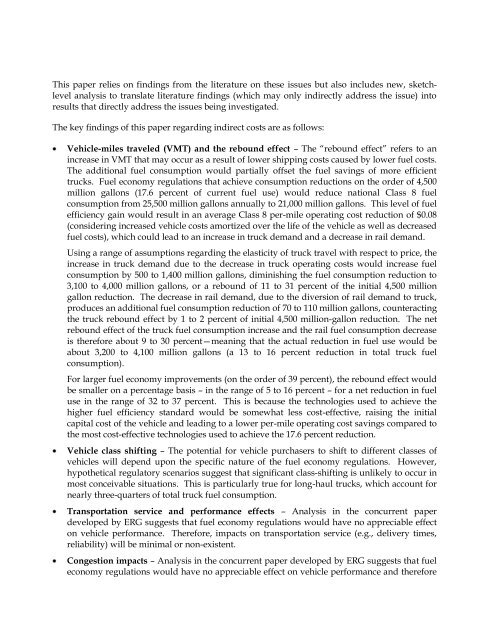Assessment of Fuel Economy Technologies for Medium and Heavy ...
Assessment of Fuel Economy Technologies for Medium and Heavy ...
Assessment of Fuel Economy Technologies for Medium and Heavy ...
Create successful ePaper yourself
Turn your PDF publications into a flip-book with our unique Google optimized e-Paper software.
This paper relies on findings from the literature on these issues but also includes new, sketchlevel<br />
analysis to translate literature findings (which may only indirectly address the issue) into<br />
results that directly address the issues being investigated.<br />
The key findings <strong>of</strong> this paper regarding indirect costs are as follows:<br />
Vehicle-miles traveled (VMT) <strong>and</strong> the rebound effect – The ―rebound effect‖ refers to an<br />
increase in VMT that may occur as a result <strong>of</strong> lower shipping costs caused by lower fuel costs.<br />
The additional fuel consumption would partially <strong>of</strong>fset the fuel savings <strong>of</strong> more efficient<br />
trucks. <strong>Fuel</strong> economy regulations that achieve consumption reductions on the order <strong>of</strong> 4,500<br />
million gallons (17.6 percent <strong>of</strong> current fuel use) would reduce national Class 8 fuel<br />
consumption from 25,500 million gallons annually to 21,000 million gallons. This level <strong>of</strong> fuel<br />
efficiency gain would result in an average Class 8 per-mile operating cost reduction <strong>of</strong> $0.08<br />
(considering increased vehicle costs amortized over the life <strong>of</strong> the vehicle as well as decreased<br />
fuel costs), which could lead to an increase in truck dem<strong>and</strong> <strong>and</strong> a decrease in rail dem<strong>and</strong>.<br />
Using a range <strong>of</strong> assumptions regarding the elasticity <strong>of</strong> truck travel with respect to price, the<br />
increase in truck dem<strong>and</strong> due to the decrease in truck operating costs would increase fuel<br />
consumption by 500 to 1,400 million gallons, diminishing the fuel consumption reduction to<br />
3,100 to 4,000 million gallons, or a rebound <strong>of</strong> 11 to 31 percent <strong>of</strong> the initial 4,500 million<br />
gallon reduction. The decrease in rail dem<strong>and</strong>, due to the diversion <strong>of</strong> rail dem<strong>and</strong> to truck,<br />
produces an additional fuel consumption reduction <strong>of</strong> 70 to 110 million gallons, counteracting<br />
the truck rebound effect by 1 to 2 percent <strong>of</strong> initial 4,500 million-gallon reduction. The net<br />
rebound effect <strong>of</strong> the truck fuel consumption increase <strong>and</strong> the rail fuel consumption decrease<br />
is there<strong>for</strong>e about 9 to 30 percent—meaning that the actual reduction in fuel use would be<br />
about 3,200 to 4,100 million gallons (a 13 to 16 percent reduction in total truck fuel<br />
consumption).<br />
For larger fuel economy improvements (on the order <strong>of</strong> 39 percent), the rebound effect would<br />
be smaller on a percentage basis – in the range <strong>of</strong> 5 to 16 percent – <strong>for</strong> a net reduction in fuel<br />
use in the range <strong>of</strong> 32 to 37 percent. This is because the technologies used to achieve the<br />
higher fuel efficiency st<strong>and</strong>ard would be somewhat less cost-effective, raising the initial<br />
capital cost <strong>of</strong> the vehicle <strong>and</strong> leading to a lower per-mile operating cost savings compared to<br />
the most cost-effective technologies used to achieve the 17.6 percent reduction.<br />
Vehicle class shifting – The potential <strong>for</strong> vehicle purchasers to shift to different classes <strong>of</strong><br />
vehicles will depend upon the specific nature <strong>of</strong> the fuel economy regulations. However,<br />
hypothetical regulatory scenarios suggest that significant class-shifting is unlikely to occur in<br />
most conceivable situations. This is particularly true <strong>for</strong> long-haul trucks, which account <strong>for</strong><br />
nearly three-quarters <strong>of</strong> total truck fuel consumption.<br />
Transportation service <strong>and</strong> per<strong>for</strong>mance effects – Analysis in the concurrent paper<br />
developed by ERG suggests that fuel economy regulations would have no appreciable effect<br />
on vehicle per<strong>for</strong>mance. There<strong>for</strong>e, impacts on transportation service (e.g., delivery times,<br />
reliability) will be minimal or non-existent.<br />
Congestion impacts – Analysis in the concurrent paper developed by ERG suggests that fuel<br />
economy regulations would have no appreciable effect on vehicle per<strong>for</strong>mance <strong>and</strong> there<strong>for</strong>e
















